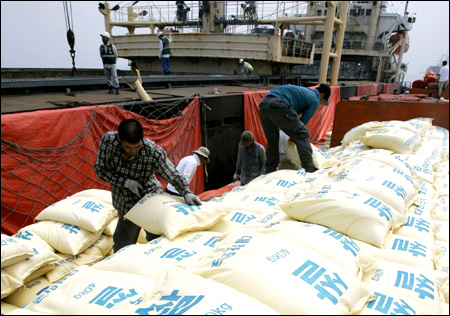Daily NK
Kim Young Jin
6/12/2007
Recently, it has been reported that businesses in charge of facial plastic surgery and skin maintenance are becoming more popular among the wealthy class.
Through a survey DailyNK conducted on actual living conditions in the Northeast region of North Korea, it was discovered that massage rooms, steam baths, beauty-related enterprises (plastic surgery and skincare maintenance) are the main thriving businesses.
Beauty-related businesses such as these prevail in relatively large-sized cities, such as Chongjin in North Hamkyung, Hamheung in South Hamkyung, and Wonsan in Kangwon. This trend seems to follow the up and coming wealthy class who have risen through doing business in North Korea.
Skin maintenance and plastic surgery which has caused a stir among the women in Shinuiju and Pyongyang have spread to inland countrysides within the last several years.
Double eye-lid surgery, eyebrow tattoos, and others can be simply performed by a plastic surgeon doctor or beauty operation specialists, so it has been widely popular among young women.
The cost of plastic surgery, in the case of double eye-lid surgery, was 500 North Korean won per one-eye in 2004, but the asking price has been 1,500 won since 2006. The North Korean exchange rate was recently 2,980 won per dollar.
In addition to double eye-lid surgery, breast augmentation has been spreading to a portion of upper-class women. The popularity of the breast enlargement surgeries demonstrates an encouragement of beauty among North Korean upper-class women.
◆ “Massages” a rage, centered on large-scale cities = Chinese-style health massages cost around 10,000 (US$3.4) North Korean won per hour and for an additional 2~30,000 won, on-the-spot sex with a female masseuse is possible.
This survey, based on the latter half of May, took place by focusing on the price of commodities in five cities, such as Kim Chaek and Chongjin City in North Hamkyung, Danchun and Hamheung in South Hamkyung, and Wonsan Kangwon.
The results of the survey showed that the region with the highest standard of living in the Northeast region is Wonsan City of Kangwon. The reason why Wonsan has a relatively high standard of living is that it has been a central place of trade with Japan.
If North Korea and China’s trade can be represented by Shinuiju, then Wonsan has played that role with trade with Japan. However, it has recently been severely targeted by the suspension in North Korea and Japan’s trade.
Wonsan’s upper-class restaurants are known to show aggressive service by shouting “Welcome” when guests come in, by decorating the interior of restaurants, and by adopting a Chinese-style waiter and waitress system.
In addition, Japanese secondhand goods have been highly traded in Wonsan. Electronic rice cookers, sewing machine, fans, TVs and other Japanese thrift goods are commonly traded and have more reasonable prices than the other regions.
Newly released 2-3 person electronic rice cookers are around 13~150,000 won, fans around 7~80,000 won, used gas stoves around 15~200,000 (approx. US$50.34~67.10), used TVs around 20~250,000 won, and flat-screen TVs over 350,000 (approx. US$117.50) won.
The supply of electricity is not an issue, so it is provided 24 hours long and electricity is better-supplied than in Hamheung.
Further, the “105 factory (furniture production factory)” in Wonsan produces furniture which is delivered to the Central Party and the quality, compared with the cost, is supposed to be the best in North Korea.
Industrial goods in Chungjin are relatively economical, but Chinese-made color TVs and flat-screen newly-released TVs are sold for 20~250,000 and 350,000 won, respectively. Used bicycles imported from Japan is sold for 10~150,000 won.
In Chongjin, the number of taxis have risen lately, but because of the expensive cost, not too many people take advantage of it. Going 4km costs around 5,000 won. Taxis that are operating are either Chinese used taxis or imported cars which are past the expiration date.
◆ The price of rice narrowly rises = In Hamheung, the cost of taxis is supposed to be slightly higher than Chongjin. There are not too many people who ride taxis, so the rate is doubled beyond the center of cities and in remote places.
The cost of penicillin has risen significantly in Chongjin, with the spread of the measles, the scarlet fever, and other infectious diseases since last winter. Chinese penicillin is hard to acquire due to its reputation for having poor quality and North Korean penicillin is sold at Jangmadang (market) for 500 won per one.
The cities considered to have low standards of living are Kim Chaek of North Hamkyung and Danchun in South Hamkyung. The size of the jangmadang (market) is smaller than in other regions and there is a limit in the variety of goods. Steam baths or massage places do not even exist. The price of medical goods are also supposed to be exorbitant.
The specialty of Kim Chaek City is its low cost of nails. The Sungjin Steel Works Complex in Kim Chaek produces nail by melting steel and sells them, which is sold for 2,200 won~2,500 won per kg in Hoiryeong, at 1,200 won in Kim Chaek. However, not only is the weight heavy and is difficult to package, but the usage by civilians is not very high, so the incidence of sale to other provinces is low.
In Danchun, the price of fruit is very expensive, so it is not sold by the kilogram unit, but is sold individually. One medium-size apple is sold for up to 800 won.
On one hand, the price of rice in North Korea’s northeast region showed a narrow upward tendency in the latter half of May at the end of the spring shortage season. Corn, the staple of low-income civilians, did not show a huge change.

